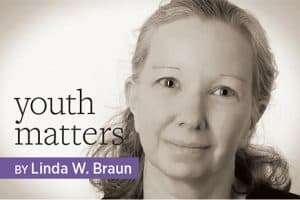
Over the past two decades, I’ve trained many library staffers on how to work with teens and have written extensively on the topic. But I haven’t always gotten it right.
With the pandemic prompting us to step back and think critically about our users and the programs we bring online, it’s also a good time to reflect on past missteps. I’d like to share some of the wrong ideas I’ve had and why some of my original thinking was incorrect, as a reminder of the importance of regularly reassessing how we serve teens through libraries.
Wrong idea: Teen-only services are essential. Over the years, I’ve talked with library staff about the need to provide teen-only services—the logic being that teens do not want to participate in activities that include parents, caregivers, or siblings. While this might be true for some teens, it is not a universal sentiment. In some cultures, and for some teens, participating in activities with other family members is an important part of life. Working with parents or caregivers to learn a new skill, helping a younger sibling with a project, or simply enjoying time together working on an activity of mutual interest is valuable for many adolescents. If libraries do not provide programs and services for teens and their families, they are putting up barriers for many in the community who would be interested in what’s available if family participation were encouraged.
Wrong idea: Off-the-shelf programming works. In my early days as a library consultant, I would fill workshops with examples of “programs that work”—programs that staffers from around the country had implemented. I’d say, “This is something you can do with your teens and be successful.” That was before I realized that the only way to serve teens is to get to know their specific interests and needs and then develop services with and for them that support both. It’s not possible to take an entire program that worked in one community and expect to replicate it in another community. Customization for a local audience is a must. For example, the rural Cherokee (Iowa) Public Library realized it couldn’t launch the type of middle school makerspace programs that worked at libraries in cities and high-tech corridors. Staffers factored in the specific interests of youth as well as the demographics, infrastructure, community assets, and available partners in their town.
If we’re willing to talk through mistakes, we can revise the way we do our jobs.
Wrong idea: Learning the technology teens are using leads to better programs. For about 10 years I facilitated workshops that simply focused on how to use a particular application or tool. These included how-to sessions on video and audio software, Google apps, and Facebook and Twitter. While library staff should have proficiency with these tools, just knowing the technology doesn’t equate to high-quality teen services. Instead, I focus now on the outcomes that staffers want to achieve through their services. Once desired outcomes are known, work backward and think about the tools needed to reach those results.
Wrong idea: Library staffers have to be where teens are online. I also used to talk about setting up social media accounts as a way to get teens to engage with the library. As I look back on that, I think, “Why would I ever suggest that?” Just as knowing how to use technology isn’t the key to success, being on social media won’t be effective if you don’t know what services teens want or don’t have a relationship in place. Instead of being everywhere that teens are online, choose platforms thoughtfully and be where you can assist teens in the activities they care about. For example, if you learn through conversations that area teens have an interest in civic engagement, you could leverage Instagram to highlight the activism of other youth and help them connect with those who share their passions and pursuits.
I’ve been wrong many more times over the past couple decades—enough to fill multiple columns—but the point is that we should all be regularly evaluating our ideas and questioning our assumptions. If we’re willing to talk through our mistakes and find ways to move forward, we can revise the way we do our jobs. Join me in being wrong—and then fixing it.

